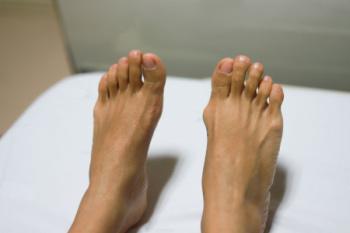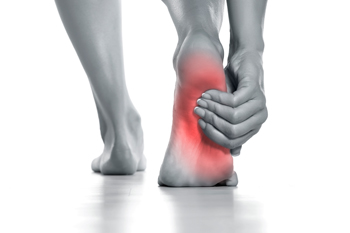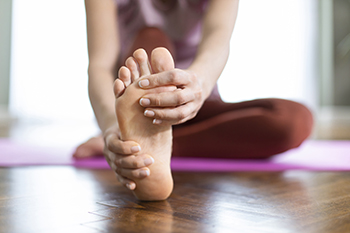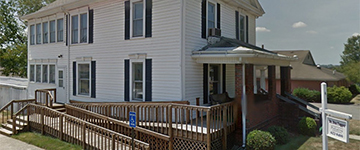Items filtered by date: February 2024
Non-Surgical Treatments for Bunions

Non-surgical treatments for bunions focus on relieving pain and discomfort, as well as slowing down the progression of the condition. Treatments include wearing comfortable shoes with a wide toe box to reduce pressure on the bunion, using padded inserts or orthotic devices to provide support and cushioning, and resting the foot to reduce swelling and inflammation. Toe spacers or splints may be used to help realign the toes gradually. Stretching and strengthening exercises for the foot and toe muscles can also improve flexibility and stability. While these treatments may not correct the bunion entirely, they can alleviate symptoms and improve quality of life for individuals with bunions who wish to avoid surgery. If you have a bunion that is causing discomfort, it is suggested that you visit a podiatrist regularly to track its progression, and adjust treatment as needed.
If you are suffering from bunion pain, contact Dr. Tupper of Coshocton Foot Health Center. Our doctor can provide the care you need to keep you pain-free and on your feet.
What Is a Bunion?
Bunions are painful bony bumps that usually develop on the inside of the foot at the joint of the big toe. As the deformity increases over time, it may become painful to walk and wear shoes. Women are more likely to exacerbate existing bunions since they often wear tight, narrow shoes that shift their toes together. Bunion pain can be relieved by wearing wider shoes with enough room for the toes.
Causes
- Genetics – some people inherit feet that are more prone to bunion development
- Inflammatory Conditions - rheumatoid arthritis and polio may cause bunion development
Symptoms
- Redness and inflammation
- Pain and tenderness
- Callus or corns on the bump
- Restricted motion in the big toe
In order to diagnose your bunion, your podiatrist may ask about your medical history, symptoms, and general health. Your doctor might also order an x-ray to take a closer look at your feet. Nonsurgical treatment options include orthotics, padding, icing, changes in footwear, and medication. If nonsurgical treatments don’t alleviate your bunion pain, surgery may be necessary.
If you have any questions, please feel free to contact our office located in Coshocton, OH . We offer the newest diagnostic and treatment technologies for all your foot care needs.
Non-Surgical Treatments for Bunions

Non-surgical treatments for bunions focus on relieving pain and discomfort, as well as slowing down the progression of the condition. Treatments include wearing comfortable shoes with a wide toe box to reduce pressure on the bunion, using padded inserts or orthotic devices to provide support and cushioning, and resting the foot to reduce swelling and inflammation. Toe spacers or splints may be used to help realign the toes gradually. Stretching and strengthening exercises for the foot and toe muscles can also improve flexibility and stability. While these treatments may not correct the bunion entirely, they can alleviate symptoms and improve quality of life for individuals with bunions who wish to avoid surgery. If you have a bunion that is causing discomfort, it is suggested that you visit a podiatrist regularly to track its progression, and adjust treatment as needed.
If you are suffering from bunion pain, contact Dr. Tupper of Coshocton Foot Health Center. Our doctor can provide the care you need to keep you pain-free and on your feet.
What Is a Bunion?
Bunions are painful bony bumps that usually develop on the inside of the foot at the joint of the big toe. As the deformity increases over time, it may become painful to walk and wear shoes. Women are more likely to exacerbate existing bunions since they often wear tight, narrow shoes that shift their toes together. Bunion pain can be relieved by wearing wider shoes with enough room for the toes.
Causes
- Genetics – some people inherit feet that are more prone to bunion development
- Inflammatory Conditions - rheumatoid arthritis and polio may cause bunion development
Symptoms
- Redness and inflammation
- Pain and tenderness
- Callus or corns on the bump
- Restricted motion in the big toe
In order to diagnose your bunion, your podiatrist may ask about your medical history, symptoms, and general health. Your doctor might also order an x-ray to take a closer look at your feet. Nonsurgical treatment options include orthotics, padding, icing, changes in footwear, and medication. If nonsurgical treatments don’t alleviate your bunion pain, surgery may be necessary.
If you have any questions, please feel free to contact our office located in Coshocton, OH . We offer the newest diagnostic and treatment technologies for all your foot care needs.
Understanding the Role of Sesamoid Bones and Sesamoiditis in the Feet

Sesamoid bones are small, specialized bones embedded within tendons, and play a critical role in the function of the feet. Positioned beneath the first metatarsal head, sesamoid bones provide leverage and support to the big toe, facilitating smooth movement and weight distribution during activities such as walking, running, and jumping. Despite their importance, sesamoid bones are prone to injury and inflammation, a condition known as sesamoiditis. Sesamoiditis typically occurs due to repetitive stress or trauma to the sesamoid bones, commonly seen in athletes engaging in activities that involve high-impact forces on the feet. Improper footwear, excessive pressure on the ball of the foot, and sudden increases in physical activity can also contribute to sesamoiditis. Symptoms of sesamoiditis include localized pain, swelling, and difficulty bearing weight on the affected foot. Recognizing the function of sesamoid bones and understanding the causes of sesamoiditis is essential for preventing and managing this painful condition. If you have any of the above symptoms, it is suggested that you schedule an appointment with a podiatrist who can accurately diagnose and treat sesamoiditis.
Sesamoiditis is an unpleasant foot condition characterized by pain in the balls of the feet. If you think you’re struggling with sesamoiditis, contact Dr. Tupper of Coshocton Foot Health Center. Our doctor will treat your condition thoroughly and effectively.
Sesamoiditis
Sesamoiditis is a condition of the foot that affects the ball of the foot. It is more common in younger people than it is in older people. It can also occur with people who have begun a new exercise program, since their bodies are adjusting to the new physical regimen. Pain may also be caused by the inflammation of tendons surrounding the bones. It is important to seek treatment in its early stages because if you ignore the pain, this condition can lead to more serious problems such as severe irritation and bone fractures.
Causes of Sesamoiditis
- Sudden increase in activity
- Increase in physically strenuous movement without a proper warm up or build up
- Foot structure: those who have smaller, bonier feet or those with a high arch may be more susceptible
Treatment for sesamoiditis is non-invasive and simple. Doctors may recommend a strict rest period where the patient forgoes most physical activity. This will help give the patient time to heal their feet through limited activity. For serious cases, it is best to speak with your doctor to determine a treatment option that will help your specific needs.
If you have any questions please feel free to contact our office located in Coshocton, OH . We offer the newest diagnostic and treatment technologies for all your foot and ankle needs.
Understanding the Role of Sesamoid Bones and Sesamoiditis in the Feet

Sesamoid bones are small, specialized bones embedded within tendons, and play a critical role in the function of the feet. Positioned beneath the first metatarsal head, sesamoid bones provide leverage and support to the big toe, facilitating smooth movement and weight distribution during activities such as walking, running, and jumping. Despite their importance, sesamoid bones are prone to injury and inflammation, a condition known as sesamoiditis. Sesamoiditis typically occurs due to repetitive stress or trauma to the sesamoid bones, commonly seen in athletes engaging in activities that involve high-impact forces on the feet. Improper footwear, excessive pressure on the ball of the foot, and sudden increases in physical activity can also contribute to sesamoiditis. Symptoms of sesamoiditis include localized pain, swelling, and difficulty bearing weight on the affected foot. Recognizing the function of sesamoid bones and understanding the causes of sesamoiditis is essential for preventing and managing this painful condition. If you have any of the above symptoms, it is suggested that you schedule an appointment with a podiatrist who can accurately diagnose and treat sesamoiditis.
Sesamoiditis is an unpleasant foot condition characterized by pain in the balls of the feet. If you think you’re struggling with sesamoiditis, contact Dr. Tupper of Coshocton Foot Health Center. Our doctor will treat your condition thoroughly and effectively.
Sesamoiditis
Sesamoiditis is a condition of the foot that affects the ball of the foot. It is more common in younger people than it is in older people. It can also occur with people who have begun a new exercise program, since their bodies are adjusting to the new physical regimen. Pain may also be caused by the inflammation of tendons surrounding the bones. It is important to seek treatment in its early stages because if you ignore the pain, this condition can lead to more serious problems such as severe irritation and bone fractures.
Causes of Sesamoiditis
- Sudden increase in activity
- Increase in physically strenuous movement without a proper warm up or build up
- Foot structure: those who have smaller, bonier feet or those with a high arch may be more susceptible
Treatment for sesamoiditis is non-invasive and simple. Doctors may recommend a strict rest period where the patient forgoes most physical activity. This will help give the patient time to heal their feet through limited activity. For serious cases, it is best to speak with your doctor to determine a treatment option that will help your specific needs.
If you have any questions please feel free to contact our office located in Coshocton, OH . We offer the newest diagnostic and treatment technologies for all your foot and ankle needs.
Treatment for Charcot-Marie-Tooth Neuropathy and Foot Pain

Charcot-Marie-Tooth, or CMT, is a genetic neuropathy that often results in pain. Approximately 80 percent of CMT patients experience pain, primarily in their feet and hands, which are the areas most affected by CMT. Interestingly, pain severity does not necessarily correlate with neuropathy severity. To manage CMT-related pain, several strategies exist. These can include oral and topical medications, behavioral interventions, and addressing sleep and mood issues. If you have foot neuropathy, it is suggested that you schedule an appointment with a podiatrist who can offer you a tailored approach to treatment.
Neuropathy
Neuropathy can be a potentially serious condition, especially if it is left undiagnosed. If you have any concerns that you may be experiencing nerve loss in your feet, consult with Dr. Tupper from Coshocton Foot Health Center. Our doctor will assess your condition and provide you with quality foot and ankle treatment for neuropathy.
What Is Neuropathy?
Neuropathy is a condition that leads to damage to the nerves in the body. Peripheral neuropathy, or neuropathy that affects your peripheral nervous system, usually occurs in the feet. Neuropathy can be triggered by a number of different causes. Such causes include diabetes, infections, cancers, disorders, and toxic substances.
Symptoms of Neuropathy Include:
- Numbness
- Sensation loss
- Prickling and tingling sensations
- Throbbing, freezing, burning pains
- Muscle weakness
Those with diabetes are at serious risk due to being unable to feel an ulcer on their feet. Diabetics usually also suffer from poor blood circulation. This can lead to the wound not healing, infections occurring, and the limb may have to be amputated.
Treatment
To treat neuropathy in the foot, podiatrists will first diagnose the cause of the neuropathy. Figuring out the underlying cause of the neuropathy will allow the podiatrist to prescribe the best treatment, whether it be caused by diabetes, toxic substance exposure, infection, etc. If the nerve has not died, then it’s possible that sensation may be able to return to the foot.
Pain medication may be issued for pain. Electrical nerve stimulation can be used to stimulate nerves. If the neuropathy is caused from pressure on the nerves, then surgery may be necessary.
If you have any questions, please feel free to contact our office located in Coshocton, OH . We offer the newest diagnostic and treatment technologies for all your foot care needs.
Treatment for Charcot-Marie-Tooth Neuropathy and Foot Pain

Charcot-Marie-Tooth, or CMT, is a genetic neuropathy that often results in pain. Approximately 80 percent of CMT patients experience pain, primarily in their feet and hands, which are the areas most affected by CMT. Interestingly, pain severity does not necessarily correlate with neuropathy severity. To manage CMT-related pain, several strategies exist. These can include oral and topical medications, behavioral interventions, and addressing sleep and mood issues. If you have foot neuropathy, it is suggested that you schedule an appointment with a podiatrist who can offer you a tailored approach to treatment.
Neuropathy
Neuropathy can be a potentially serious condition, especially if it is left undiagnosed. If you have any concerns that you may be experiencing nerve loss in your feet, consult with Dr. Tupper from Coshocton Foot Health Center. Our doctor will assess your condition and provide you with quality foot and ankle treatment for neuropathy.
What Is Neuropathy?
Neuropathy is a condition that leads to damage to the nerves in the body. Peripheral neuropathy, or neuropathy that affects your peripheral nervous system, usually occurs in the feet. Neuropathy can be triggered by a number of different causes. Such causes include diabetes, infections, cancers, disorders, and toxic substances.
Symptoms of Neuropathy Include:
- Numbness
- Sensation loss
- Prickling and tingling sensations
- Throbbing, freezing, burning pains
- Muscle weakness
Those with diabetes are at serious risk due to being unable to feel an ulcer on their feet. Diabetics usually also suffer from poor blood circulation. This can lead to the wound not healing, infections occurring, and the limb may have to be amputated.
Treatment
To treat neuropathy in the foot, podiatrists will first diagnose the cause of the neuropathy. Figuring out the underlying cause of the neuropathy will allow the podiatrist to prescribe the best treatment, whether it be caused by diabetes, toxic substance exposure, infection, etc. If the nerve has not died, then it’s possible that sensation may be able to return to the foot.
Pain medication may be issued for pain. Electrical nerve stimulation can be used to stimulate nerves. If the neuropathy is caused from pressure on the nerves, then surgery may be necessary.
If you have any questions, please feel free to contact our office located in Coshocton, OH . We offer the newest diagnostic and treatment technologies for all your foot care needs.
Osteoarthritis in the Big Toe

Osteoarthritis, or OA, in the big toe is medically referred to as hallux rigidus. This progressive and degenerative condition is characterized by the breakdown of cartilage at the first metatarsophalangeal, or MTP, joint. As the cartilage in the MTP joint deteriorates, the bones rub together, causing pain, swelling, and stiffness. This discomfort in the big toe often leads to difficulty in bending the toe, and affects mobility and everyday activities, like walking. Furthermore, OA in the big toe can worsen other foot conditions, such as bunions, corns, calluses, and hammertoes. This may further complicate movement and cause additional discomfort. Treatment options for OA in the big toe start with conservative methods, such as pain management and custom orthotic devices. In more severe cases, surgical intervention may be suggested, depending on the severity of the condition and the patient's individual needs. Seeking prompt medical attention from a podiatrist is important for diagnosing and managing hallux rigidus effectively, as early intervention can help to alleviate symptoms, improve mobility, and enhance overall quality of life for individuals affected by this condition. If you believe you may have osteoarthritis that is affecting the big toe, it is suggested that you schedule an appointment with a podiatrist.
Toe pain can disrupt your daily activities. If you have any concerns, contact Dr. Tupper of Coshocton Foot Health Center. Our doctor can provide the care you need to keep you pain-free and on your feet.
What Causes Toe Pain?
Most severe toe pain is caused due to a sports injury, trauma from dropping something heavy on the toe, or bumping into something rigid. Other problems can develop over time for various reasons.
Toe pain can be caused by one or more ailments. The most common include:
- Trauma
- Sports injury
- Wearing shoes that are too tight
- Arthritis
- Gout
- Corns and calluses
- Hammertoe
- Bunions
- Blisters
- Ingrown toenails
- Sprains
- Fractures (broken bones)
- Dislocations
When to See a Podiatrist
- Severe pain
- Persistent pain that lasts more than a week
- Signs of infection
- Continued swelling
- Pain that prevents walking
Diagnosis
In many cases the cause of toe pain is obvious, but in others, a podiatrist may want to use more advanced methods to determine the problem. These can range from simple visual inspections and sensation tests to X-rays and MRI scans. Prior medical history, family medical history, and any recent physical traumatic events will all be taken into consideration for a proper diagnosis.
Treatment
Treatments for toe pain and injuries vary and may include shoe inserts, padding, taping, medicines, injections, and in some cases, surgery. If you believe that you have broken a toe, please see a podiatrist as soon as possible.
If you have any questions please feel free to contact our office located in Coshocton, OH . We offer the newest diagnostic tools and technology to treat your foot and ankle needs.


